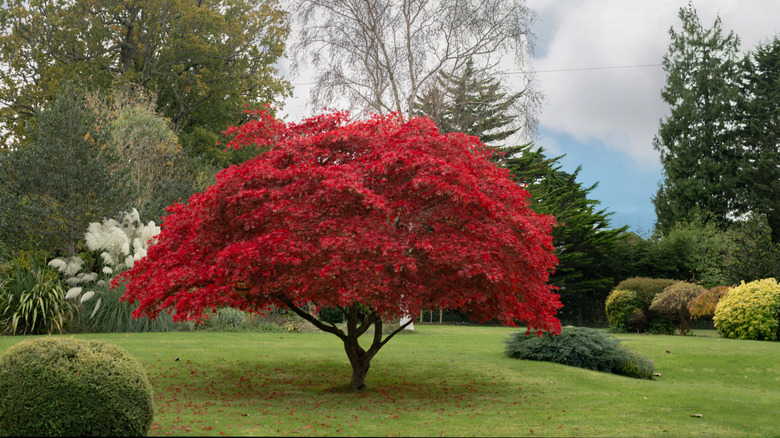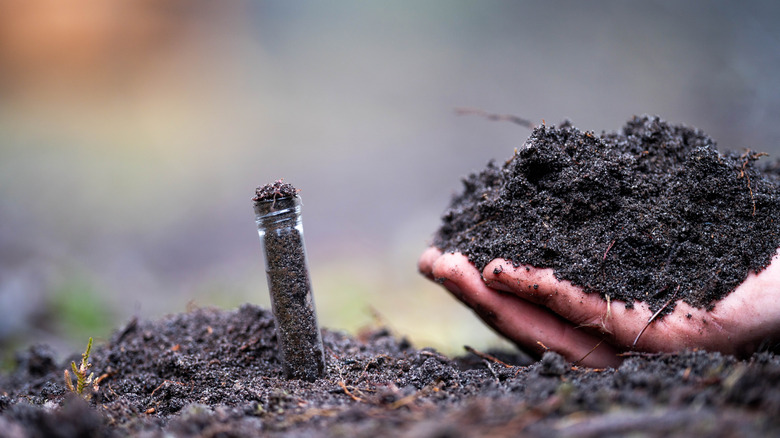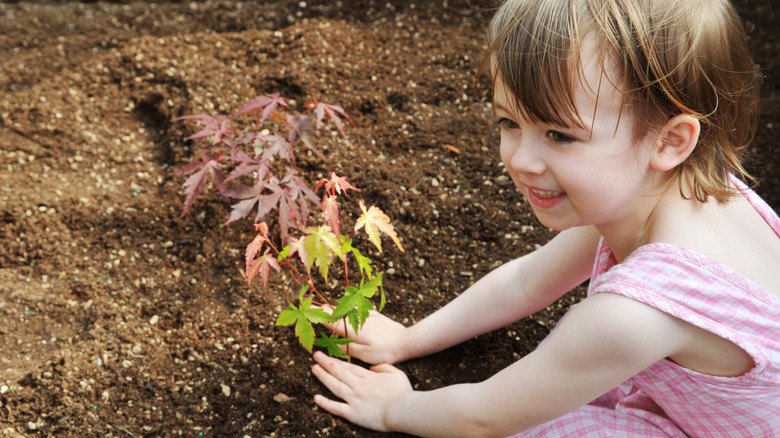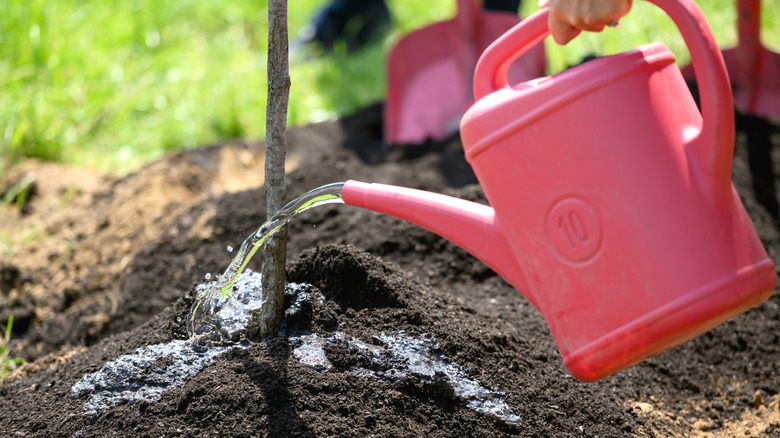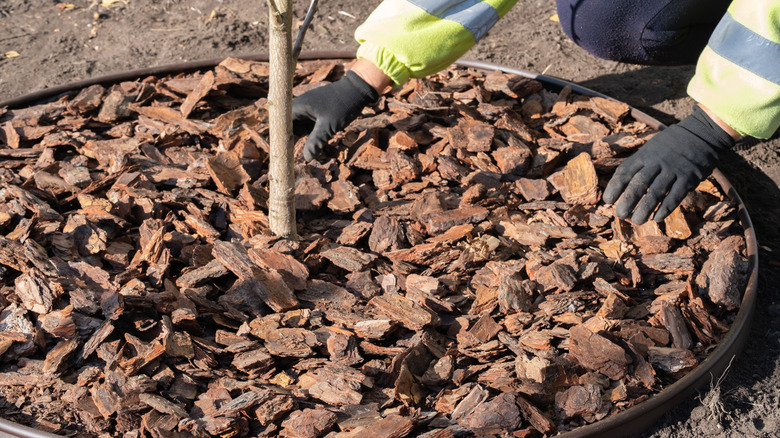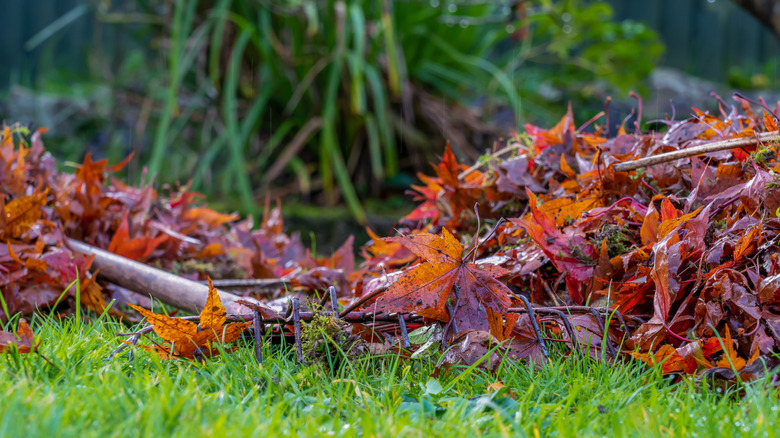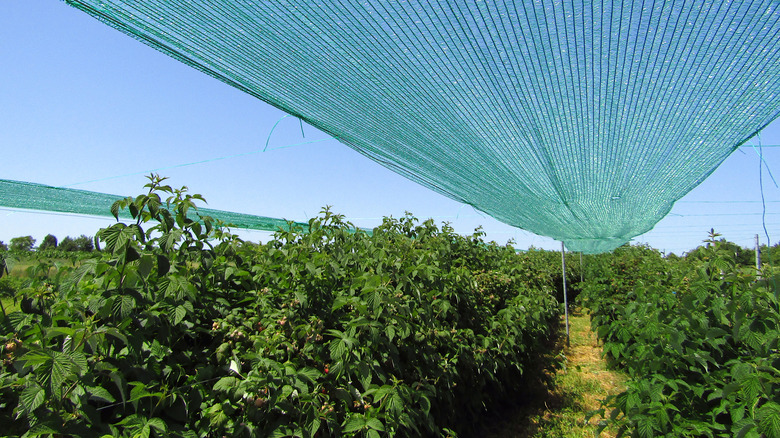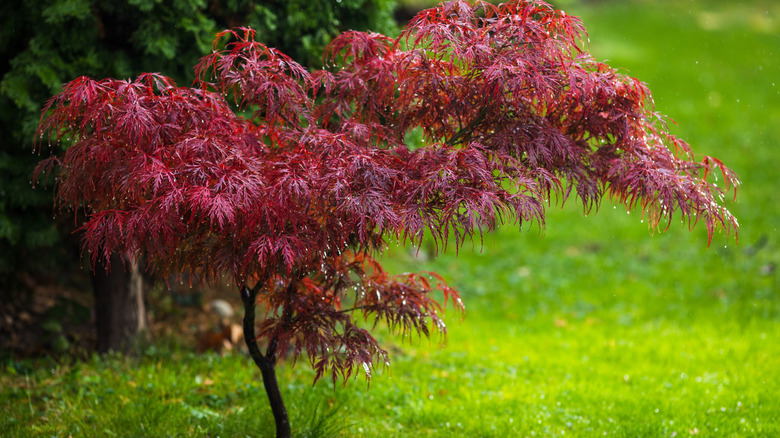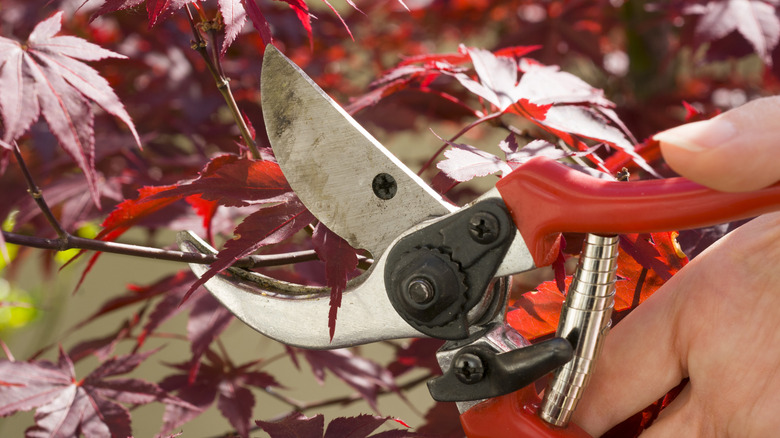Essential Tips For Taking Care Of A Japanese Maple (Especially In The Hot Summer)
We may receive a commission on purchases made from links.
Is there anything more striking than seeing a Japanese maple (Acer palmatum) in its full splendor? The eye-catching red color of its leaves, its graceful arching — it's enough to make anyone want to refresh their landscaping to make room for just one more tree. Since Japanese maples are slow growers and fairly tolerant of whatever you throw at them, you might think they're hardy enough to withstand serious climate shifts. Unfortunately, that's just not the case; A. palmatums can only handle so much harshness, particularly during the summer, when they struggle against the high temperatures and abundant sunshine.
So, rather than watching your maple wilt in the hot summer sun, we're here to help. We've found 12 essential tips that will ensure your maple tree keeps that brilliant foliage lush for years to come. But don't worry that you'll need to become a master gardener to keep this tree happy; anyone can successfully care for this beautiful tree — you just need to know what it needs and why.
Do a soil test first to make sure your Japanese maple has everything it needs to survive harsh summers
While it might seem trivial or on the "someday" to-do list, getting a soil test done is a critical component for ensuring your Japanese maple survives the harsh summer weather. While overall tolerant of various soil types, when you're dealing with a tree that has such delicate roots and stems, giving it the best foundation possible ensures it can pull the resources it needs to make it through. If they don't have the soil nutrients they need, the tree can become stressed during the time of year it needs its strength the most. Think of it like giving yourself a daily multivitamin. Sure, you could live without it, but when flu season comes around you'll be glad you gave your body the best protection possible.
A. palmatums do best in soil that has a slightly acidic pH level and most soil tests will give you your pH results on even the most basic package. You can DIY a soil test easily or leave it to the pros at your local university extension. Some will do it for free, while others charge a nominal fee and will give you a detailed report that lets you know the quality of your soil, its pH level, and any fertilizer recommendations they have to give your landscape a little nutrient boost. Also, don't skip this if you've already planted your maple; getting the test done before the summer hits will let you know which types of fertilizers or additives your established tree needs to bounce back from any potential sun scorching or drought conditions that typically come along with the hot summer temperatures.
Plant it at the right depth to protect its root ball from the sun
Japanese maples are hardy, but have thin roots, stems, and bark, so they need to be planted just so to ensure they're protected from sun scorching. If your tree is planted too shallowly, it's possible the midday sun could heat the roots or scorch the trunk. On the flip side, planting it too deep could put bark under the soil line, which makes it easy for root rot pathogens to infiltrate the tissue, which in turn makes it hard for your tree to have the stamina it needs to combat rising temperatures.
The ideal hole for a Japanese maple's root ball is one that's wide and shallow. The best way to dig the perfect planting hole for your tree is to shoot for a width that's around three times wider than the root ball and is only deep enough to just cover below where the trunk begins to flare. Ideally, the flare should be just above the soil line. And pay particular attention to the flare if you've purchased a grafted tree — the root stock's flare is the place to stay attentive to, and not where the graft was added. If you've already planted your tree and are worried it's too deep, try to remove excess soil around the tree base to help get the flare out of the soil and into fresh air.
Don't neglect your watering routine
One of the benefits of planting your maple in the ground instead of a container is that it has more access to moisture around your landscape, which comes in handy during those super hot summer days. An established Japanese maple can be somewhat drought-tolerant, but still needs a drink to help it retain moisture in its branches and trunk throughout the summer months. If it doesn't get the water it needs, it won't be able to sustain itself in conditions where the humidity is low and the temperatures are high.
How much water your Japanese maple needs depends on how long it's been in your yard. Saplings and newly-planted trees should be watered at least three times a week during the summer and regularly watered in cooler months during its first year. Water early in the morning if you can to prevent the soil from staying too moist for too long since this can create an ideal ground for root rot. Also, don't just do a once over with your hose; water deeply at the base (about 12-18 inches deep into the soil) and try to keep the leaves dry so that the water doesn't evaporate, preventing the soil from getting any.
Mulch around the planting site to retain moisture around your maple
Moisture is absolutely critical for the longevity of a Japanese maple, particularly in climates that get very hot and dry. While we know you want to be diligent with your watering routine, sometimes you might accidentally skip a day or realize that it's just not enough to help keep your maple healthy when the days are long and evaporation is high. So give yourself a helping hand by laying down some mulch around the tree's planting area; mulching around trees will help retain soil moisture and keep the soil cool, protecting the tree's roots. Plus, as the natural mulch decomposes, your tree will get a fresh dose of nutrients from the organic material, which can definitely come in handy in extended heat waves when the tree is stressed.
Mulching around a Japanese maple requires a little bit of strategy, but it's not so precise that you should feel intimidated. First, don't mulch right up to the trunk or over the first order root, which are just the lateral roots popping above the soil line, but you can mulch around them. There are lots of eco-friendly natural mulch options, but you should use a mulch that compliments your soil's nutrient makeup and spread around 2 to 3 inches' worth. For example, if your soil test shows a low level of nitrogen, toss down a little sawdust since it can boost nitrogen levels.
Don't clean up dead leaves, because they'll protect the trunk
Even if you've already got a nice layer of mulch, your trees fallen leaves can be incredibly beneficial for protecting its more delicate parts from sun burn. Fallen leaves work like a natural sunscreen, because they help protect a maple's trunk, roots, and branches from direct sunlight, which is helpful during the peak of summer when the days are long and there's little shade. Plus, fallen leaves give soil an extra nutrient boost; they're free and already compliment the tree's aesthetics — it's a win-win-win.
Like other mulches, it's important to clean up leaf piles that collect around the base of the maple to prevent excess moisture from inviting pathogens into the thin tissue. Also, occasionally give your fallen leaves a once over to check for signs of fungal or bacterial disease, as you don't want those getting back into the soil. If you notice any mold or fungal growth, toss those leaves and check the tree to ensure there's no infection. Skip the compost heap, too, so that the disease doesn't end up on other plants.
Protect it from the hot afternoon sun
There are a few species of A. palmatum that are considered more sun-tolerant than others, but even they have a limit. When the sun is high and the days are long, dry, and hot, Japanese maples can begin to scorch. Your maple will be happiest in areas with dappled light or morning sun, but if that's not an option, then you'll need to make accommodations to keep your tree protected.
There are a couple of ways you can keep your maple's foliage protected from full sun. One option is to DIY a sun shade using PVC pipe and shade cloth. Another option is to buy shade covers that go over the tree, like this ESOHOT Fruit Tree Netting with Zipper Drawstring, though this might be hard to swing if your tree has a wide canopy or you're trying to cover it alone. You can also plant fast growing trees that can create shade as they outgrow the slower-growing maple, but make sure they're suitable for your soil type and climate.
Maintain higher humidity levels around the tree, if possible
Japanese maples come from, you guessed it, Southeast Asia, so are used to climates that balance heat with humidity. If your maple is in an area that has low humidity during the summer, it will be hard for it to retain the moisture it needs in its branches that support the foliage. If the conditions get too dry, you'll start to see the leaves turning brown and crispy, because the tree will begin to conserve resources to protect the root ball. It's sort of like how the human body will protect itself from hypothermia, just, we guess, in reverse.
If there's not much humidity in the foreseeable future, begin by focusing on maintaining moisture around the roots. To recap: Add a fresh layer of mulch around the base (but remember to leave some space around the lateral roots and trunk), consider upping your watering schedule, and keep the lawn tools away from the bark to prevent any accidental wounding of the tree where moisture can seep out. Also, adding sun shades prevents sunlight from hitting the tree directly, so that its "microclimate" — the area around it — stays a few degrees cooler and moister.
Wait until the fall to prune
Beautiful, tidy landscapes are certainly key features of the summer, but getting prune-happy with your maple could be detrimental to its health. Pruning trees during the hot summer months can stress your maple out, making it more susceptible to disease or infection. Plus, any wounds are now open areas where its much-needed moisture can seep out. Granted, a pruned branch isn't going to turn into a fire hose, but every little bit of water your maple can maintain during the height of summer helps more than you think.
Of course, there are a few caveats to this. If your tree has diseased or infected areas, it's better to get rid of those than to leave them on for the sake of moisture. Dead branches or leaves can be removed, too, but you might want to consider letting them fall to the ground so that they act like a natural mulch that keeps the soil cool and moist. If you feel like your maple needs a bit of a trim, wait for the early spring or late winter when it's just about to begin its new growing season.
